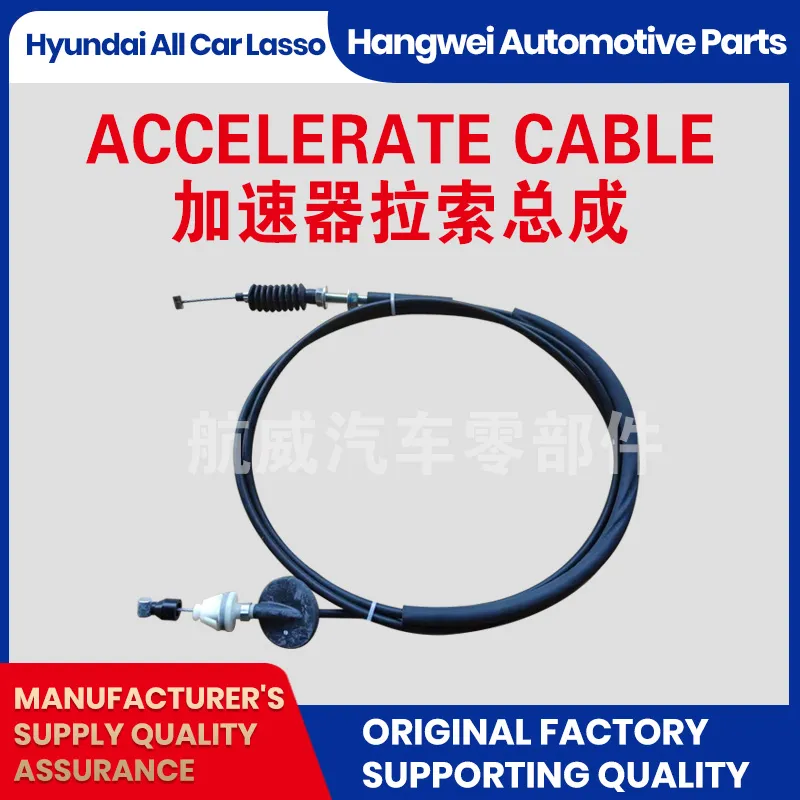Need a Throttle Cable with Universal Fit and Smooth Control?
Accelerator Push-Pull Cable: the humble throttle cable that still moves markets
Drive-by-wire gets all the headlines, but talk to fleet managers, motorcycle techs, or off-road equipment buyers and they’ll tell you: a well-made throttle cable remains the most predictable way to convert pedal intent into engine response. In fact, the Accelerator Push-Pull Cable from HWEI keeps popping up in teardown notes I’ve seen this year—largely for its steady friction characteristics and tidy end fittings.

Where it fits and why it wins
You’ll see this style of throttle cable in light commercial vehicles, motorcycles, ATVs/UTVs, small marine engines, gensets, and plenty of specialty equipment. Advantages? Immediate mechanical feedback, no sensor drift, easier field service, and—surprisingly—better cost control over the product life cycle when the environment is dusty or wet.
Real-world specs (typical)
| Product Name | Accelerator Push-Pull Cable |
| Inner Wire | Stainless steel 1×19 strand, Ø≈1.2–2.5 mm (options) |
| Liner & Conduit | PTFE-lined PA/HDPE conduit, low-friction jacket |
| End Fittings | Zinc–nickel plated steel; custom ball/clevis/barrel ends |
| Operating Temp | −40 °C to +120 °C (real-world use may vary) |
| Cycle Life | ≥200,000 cycles at rated load (lab), field ≈150–300k |
| Tensile (Pull-Out) | ≥1.5 kN on swaged ends (typical) |
| Corrosion | 240–480 h neutral salt spray per ASTM B117/ISO 9227 |
| Origin | Qinghe County Minjiang Street south, Wuzhishan Road east |
Process flow that actually matters
Materials are incoming-inspected (wire diameter, plating thickness), strands are cut and swaged with calibrated dies, conduit is extruded and PTFE-lined, then assemblies are crimped and proof-loaded. Friction is checked on a stroke rig, and random samples run salt-spray and thermal cycling. To be honest, the boring part—consistent swage calibration—makes or breaks a throttle cable.
Tests referenced: tensile pull-out, 100% functional stroke test, ASTM B117/ISO 9227 salt spray, environmental cycling aligned to ISO 16750 vibes/temps (where relevant), and dimensional audits to drawing. Certifications often include ISO 9001 and IATF 16949; RoHS/REACH compliance on request.
Customization and use cases
Lengths from under 300 mm to >2 m, custom barrels and clevises, return springs, and bracketry. I’ve seen builders spec a dual redundant throttle cable for rally cars (belt-and-suspenders approach). Fleet vans prefer sealed boots to survive winter grit; small marine users like stainless everything, even the ferrules.
Vendor comparison (indicative)
| Vendor | Cycle Life | Salt Spray | Lead Time | Certs |
|---|---|---|---|---|
| HWEI (this product) | ≈200k–300k cycles | 240–480 h | Around 2–4 weeks (custom) | ISO 9001, IATF 16949 |
| Generic import | ≈100k–150k | 96–240 h | 1–6 weeks | Varies |
| Boutique performance | ≈250k+ | 480 h+ | 4–8 weeks | ISO 9001 (often) |
Field notes and feedback
Many customers say pedal effort stays “light but not vague” past 50,000 km. One delivery fleet switched to this throttle cable spec and reported a 37% drop in winter sticking incidents versus their previous unit (internal logbook, anecdotal but consistent). A small OEM told me they liked the predictable pull-out numbers: easier to certify the bracket design.
Industry trends (quick take)
Yes, electronics are eating into mechanical control, but for cost-sensitive platforms and harsh-duty gear, a sealed push-pull throttle cable remains hard to beat—lower BOM cost, clear failure modes, and simple service. Expect incremental gains: better liners, improved plating chemistry, and smarter boots rather than radical redesigns.
Certifications and standards referenced
ISO 9001, IATF 16949, ASTM B117 / ISO 9227 for corrosion, and environmental test plans aligned to ISO 16750 where applicable. RoHS and REACH compliance typically available on documentation.
Citations
- ASTM B117: Standard Practice for Operating Salt Spray (Fog) Apparatus
- ISO 9227: Corrosion tests in artificial atmospheres — Salt spray tests
- ISO 16750: Road vehicles — Environmental conditions and testing
- ISO 9001: Quality management systems
- IATF 16949: Automotive QMS standard
- RoHS Directive (EU) overview
- REACH Regulation overview
-
Clutch Line: Braided, Leak-Proof, OEM-Grade PerformanceNewsNov.10,2025
-
Throttle Cable: Durable, Smooth Control & Universal FitNewsNov.10,2025
-
Throttle Cable: Durable, Smooth, Universal Fit, Easy InstallNewsNov.10,2025
-
Clutch Line: Durable, Leak-Proof, OEM-Grade PerformanceNewsNov.10,2025
-
Hand Brake Cable | Custom, Universal & Trailer SolutionsNewsNov.10,2025
-
Clutch Line: High-Pressure, OEM-Fit, Corrosion-ResistantNewsNov.03,2025
